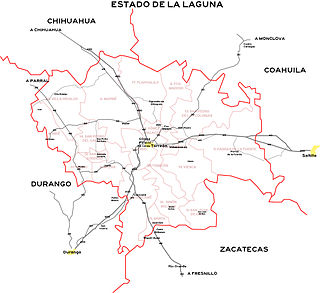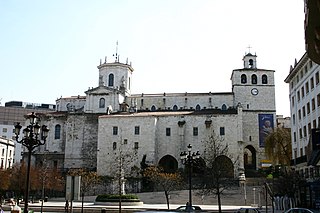
Ferdinand I, called the Great, was the count of Castile from his uncle's death in 1029 and the king of León after defeating his brother-in-law in 1037. According to tradition, he was the first to have himself crowned Emperor of Spain (1056), and his heirs carried on the tradition. He was a younger son of Sancho III of Navarre and Muniadona of Castile, and by his father's will recognised the supremacy of his eldest brother, García Sánchez III of Navarre. While Ferdinand inaugurated the rule of the Navarrese Jiménez dynasty over western Spain, his rise to preeminence among the Christian rulers of the peninsula shifted the focus of power and culture westward after more than a century of Leonese decline. Nevertheless, "[t]he internal consolidation of the realm of León–Castilla under Fernando el Magno and [his queen] Sancha (1037–1065) is a history that remains to be researched and written."

San Pedro Sula is the capital of Cortés Department, Honduras. It is located in the northwest corner of the country in the Sula Valley, about 50 kilometers south of Puerto Cortés on the Caribbean Sea. With a population of 701,200 in the central urban area and a population of 1,445,598 in its metropolitan area in 2023, it is the nation's primary industrial center and second largest city after the capital Tegucigalpa, and the largest city in Central America that is not a capital city.

San José is the capital and largest city of Costa Rica, and the capital of the province of the same name. It is in the center of the country, in the mid-west of the Central Valley, within San José Canton. San José is Costa Rica's seat of national government, focal point of political and economic activity, and major transportation hub. San José Canton's population was 288,054 in 2011, and San José's municipal land area is 44.2 square kilometers, with an estimated 333,980 residents in 2015. Together with several other cantons of the central valley, including Alajuela, Heredia and Cartago, it forms the country's Greater Metropolitan Area, with an estimated population of over 2 million in 2017. The city is named in honor of Joseph of Nazareth.

Aguascalientes, officially the Free and Sovereign State of Aguascalientes, is one of the 32 states which comprise the Federal Entities of Mexico. At 22°N and with an average altitude of 1,950 m (6,400 ft) above sea level it is predominantly of semi-arid climate. The state is located in west-central Mexico and is located in the northern part of the Bajío region, which is in the north-central part of the country, bordered by Zacatecas to the north, east and west, and by Jalisco to the south.

A presidio was a fortified base established by the Spanish Empire between the 16th and 18th centuries in areas under their control or influence. The term is derived from the Latin word praesidium meaning protection or defense.

The Comarca Lagunera or La Comarca de la Laguna is a region of northern Mexico occupying large portions of the states of Durango and Coahuila, with rich soils produced by periodic flooding of the Nazas and Aguanaval rivers. Neither river drains into either the Pacific Ocean or the Gulf of Mexico, but rather they created a series of inland lakes. The region was developed for large-scale irrigated cotton agriculture. During the Mexican Revolution, the region was the site of fierce fighting. Following the military phase of the Revolution, the region was part of the agrarian reform under President Lázaro Cárdenas. The dam named for Cárdenas now controls flooding of the rivers, but the groundwater resources are no longer recharged as a result. It is the 8th largest metropolitan area in Mexico.
San Pedro Alcántara is a town in the municipality of Marbella, in Andalucía, Spain. It is a touristic destination of the Costa del Sol.
The Congress of Tucumán was the representative assembly, initially meeting in San Miguel de Tucumán, that declared the independence of the United Provinces of South America on July 9, 1816, from the Spanish Empire.

Pedro León Díaz Gallo was an Argentine statesman and Catholic priest. He was a representative to the Congress of Tucumán which on 9 July 1816 declared the Independence of Argentina.

López de Micay is a town and municipality in the Cauca Department, Colombia. It is located on the Pacific Coast of the Cauca Department in the Naya Region on the foothills of the Colombian Western Cordillera. It is located 84 km from the departmental capital, Popayán.

The Diocese of Santander is a Latin Church diocese of the Catholic Church seated in Santander Cathedral in the city of Santander in the ecclesiastical province of Oviedo in Spain.

Mapimí is a municipality in the Mexican state of Durango. The municipal seat lies at Mapimí. The municipality covers an area of 7,126.7 km².

San Pedro del Gallo is a municipality in the Mexican state of Durango. The municipal seat lies at San Pedro del Gallo. The municipality covers an area of 2,008.3 km².

María Asunción Balaguer Golobart was a Spanish actress. She appeared in more than 100 films and television shows from 1952 to 2016. In 1983, she played El barón, by Leandro Fernández de Moratín. In 1984, she played La cena del rey Baltasar, by Pedro Calderón de la Barca.
The Pacific Coast Basketball Circuit, officially known as the Chevron CIBACOPA for sponsorship reasons, is ten team basketball league based in Northwestern Mexico. The matches take place from March to June.
Events in the year 1952 in Mexico.

Sueño de amor is a Mexican telenovela produced by Juan Osorio for Televisa. It is also broadcast in Univision in the United States.

The Great Clock of Lima, also known as the Pedro Ruiz Gallo clock after its inventor, was a monumental clock created by Pedro Ruiz Gallo, and which was installed in the Parque de la Exposición in 1870 for the celebration of the Exhibition of 1872. The watch disappeared during the occupation of Lima by the Chilean Army in the War of the Pacific.















